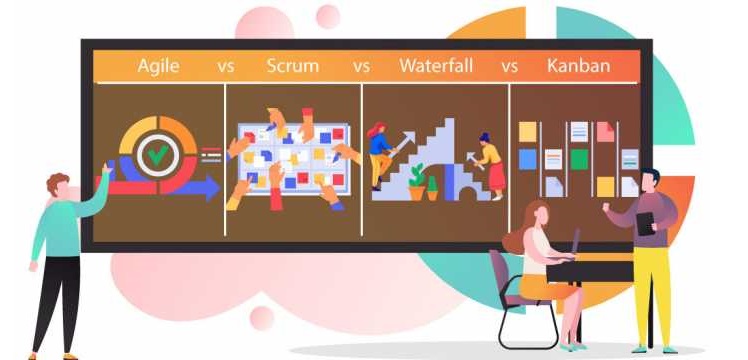What is Agile?
Agile is an approach to software development that uses an iterative and incremental approach to assist in project completion. The Agile methodology is a flexible way of solving problems in any development process because it is open to evolving environments. It uses feedback from users to improve its product over time and prioritizes based on what adds the most value to the customer.
The leaders are focused on creating an environment and a team that works together and has a sense of ownership and believes in face-to-face communication. The main focus is to create a product that meets all customer needs as well as the business goals of a company. The Agile Manifesto was created in 2001 to give other software developers and their teams a guideline on ways they could improve their software development process.
What is Scrum?
Scrum is possibly the most widely used subset of Agile because the success rate is quite high. 63% of projects that used the Scrum method were completed on time and were successful. The Scrum process is made of fixed-length iterations known as sprints that go on for about two to three weeks on average. After each sprint, all stakeholders and team members meet to plan their next sprint and continue to do so till the project is complete.
What is Waterfall?
The Waterfall method is considered to be the traditional way of completing projects. It is widely used and follows a linear process through the development cycle. It works on creating a hierarchy or levels of stages that need to be completed in order to finish the project. It is a rigid method of project completion that often leads to delays and failures. It does not leave room for any changes and if the team members want to go back one step, they will have to start from the top.
What is Kanban?
Kanban is another widely used subset of Agile. The main focus of this framework is that it creates a visual representation of what the development teams need to produce when to do it and its quantity. Kanban is focused on making small changes to the current system that will help improve it. Kanban can work alongside existing workflows as well.
The Kanban method was created in the 1940s when the Toyota Production System decided to follow the same approach as a supermarket did when it came to inventory – they did not put too many of the same items in one go, and replaced them only when it was empty, and so on. It creates a visual representation of the bandwidth, time, and space it takes for each project and different ways to improve its workflow.
Agile vs. Waterfall vs. Kanban vs. Scrum
There are a lot of similarities and differences with each methodology but they all have the same main goal, which is to complete projects. The best way to understand the differences between the four methods in a project would be to understand what is unique about each one.
What is it That Makes Agile Unique?
As discussed above, Agile focuses on taking a more collaborative and self-organizing approach to software development and project management. It is a widely accepted methodology that has various subsets including Scrum and Kanban. It doesn’t come with proper techniques for implementation, just some guiding principles.
What makes Agile unique is that it is adaptive to change and focuses on team members working simultaneously by breaking the project down into smaller and iterative periods. Agile teams work incrementally so that team members can easily adjust their processes depending on the change in requirements.
What is it That Makes Scrum Unique?
Scrum is a subset of Agile, which means the guiding principles for project completion and software development remain the same. The Scrum method is typically used to complete projects that require a lot of changes made in a very short amount of time. The sprints or iterations in Scrum last no more than 3 weeks at most. Scrum teams plan and create a backlog before starting a sprint and complete it during the sprint. Then they review their work, create another plan, and start the process again.
Since the Scrum process is fast-paced, team members hold daily meetings to discuss their progress and issues with the project to help them solve problems as soon as they arise. A Scrum team has a Scrum Master to help facilitate the sprint instead of managing it so that all roadblocks can be removed easily and the sprint can go on without any hindrances.
What is it That Makes Waterfall Unique?
Here, projects are split into linear stages that follow a sequence. Only after Step 1 is complete and reviewed can the development team start working on Step 2. The unique traits of the Waterfall method are that it works with terminal phases because it started as a part of construction and manufacturing. It is distinctly phased out so there is no lack of focus during each stage of development.
Another unique trait of the Waterfall method is that all project requirements are made extremely clear before the beginning of the project. If a team wants to go back even by one step, they’ll have to start all over again. This makes all documentation of requirements very thorough and accessible through every step of the project completion process.
What is it That Makes Kanban Unique?
Since Kanban is a subset of Agile, the main principles remain the same. The focus of the Kanban framework is to create a balanced work environment and improve coordination among team members. What makes Kanban unique is that its ‘Kanban Board’ helps in visualizing how the team works by splitting the total project into tasks that are completed, tasks that need to be completed, and tasks that are in progress. Each task is recorded and keeps shifting based on the progress it has made.
Another aspect of the Kanban method is that it limits the workflow so that the team members do not get overwhelmed. There are only a certain amount of tasks in progress at any given time, depending on the number of members in the team. Kanban does not necessarily need to have a process of its own, it can work along with existing processes by helping continuously improve their processes with regular meetings based on the Kanban board.
Final Thoughts
Even though all four of the methodologies are focused on achieving the same goal, they take different approaches to getting it done. To understand which methodology works best for your company and how to properly implement it in your teams so that you can gain the most out of it, there are various industry-recognized Agile Certification Courses that will help you along the way.
Source: invensislearning.com



















